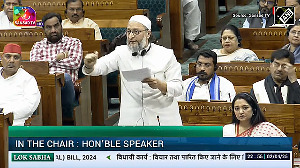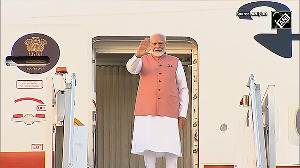 The inflation rate has been in double digits for several months now and the real return to depositors has been negative since the beginning of the year.
The inflation rate has been in double digits for several months now and the real return to depositors has been negative since the beginning of the year.
As the first quarter review of the credit policy approaches, voices from the market are getting louder by the day that 'baby steps' may not be sufficient to fight rising prices.
During the annual policy review in April, Reserve Bank of India Governor D Subbarao had said moving in several baby steps towards normalisation was better for the economy.
The central bank's stance -- viewed as reactive -- was based on the reasoning that any drastic step could have hurt the economic recovery and a sharp rise in policy rates would only have a limited impact, as price rise was more driven by supply side constraints.
"Theoretically, monetary policy is most effective when it is forward looking. However, drastic actions on the rate front not only caused major distortions, but would have offered no help to solve supply side problems. Food prices would not have come down if rates were raised sharply.
"The effect of the rate increase was limited to solving demand-side factors like manufacturing sector prices," said Madan Sabnavis, chief economist, Care Ratings.
However, market analysts now say the time has come to change gears.
"I thought in April, RBI would raise rates by 50 basis points. It didn't. Given the pace of inflation, RBI should raise rates more aggressively.
"But I don't think it will. I think RBI is still concerned about the global recovery and the lack of strong private sector credit. RBI will probably go with a series of 25-basis-point hikes" Jahangir Aziz, J P Morgan's chief economist in India, told Business Standard.
"The central bank should shed its diffidence and sound more hawkish on inflation," wrote A Prasanna, vice-president, ICICI Securities Primary Dealership, in a recent report.
The headline inflation rate for June rose to 10.55 per cent from 10.16 per cent in May, despite a slight decline in food inflation indices.
A Goldman Sachs report expects 75-basis-point increase in policy rates during the remaining part of 2010. On July 2, RBI had raised repo and reverse repo rates by 25 basis points each to 5.5 per cent and 4 per cent, respectively.
The tight liquidity at present, mainly due to the auction of 3G and broadband wireless access spectrum, has pushed short-term rates by as much as 150 basis points, making RBI believe, operative rate is towards the repo rate.
However, analysts pointed out that hardening of rates might be temporary, as rates would fall once the government starts spending.
"The dominant view is that this tightness in liquidity is temporary, and when the government starts spending its windfall gains from the 3G auctions, liquidity will ease, and effective policy rates will move down towards the reverse repo rate from the repo rate," the Goldman Sachs report says.
Hence, the need to narrow the rate corridor is viewed as essential, as the regulator seems to believe that a comfortable liquidity outlook is indicated by withdrawing the special liquidity facility given to banks.
On May 26, as a temporary measure, RBI had said banks would not be penalised if they fell below their Statutory Liquidity Ratio, which was 25 per cent of net time and demand liabilities, by 50 basis points, while they pledged government securities for borrowing through the repo route.
The measure was extended till July 16, but withdrawn the penultimate day.
"We believe RBI should consider narrowing the Liquidity Adjustment Facility corridor, given that the liquidity outlook is uncertain. We place a 25 per cent probability that RBI would raise the reverse repo rate by 50 basis points and the repo rate by 25 basis points in the policy," said ICICI Securities' Prasanna.










 © 2025
© 2025